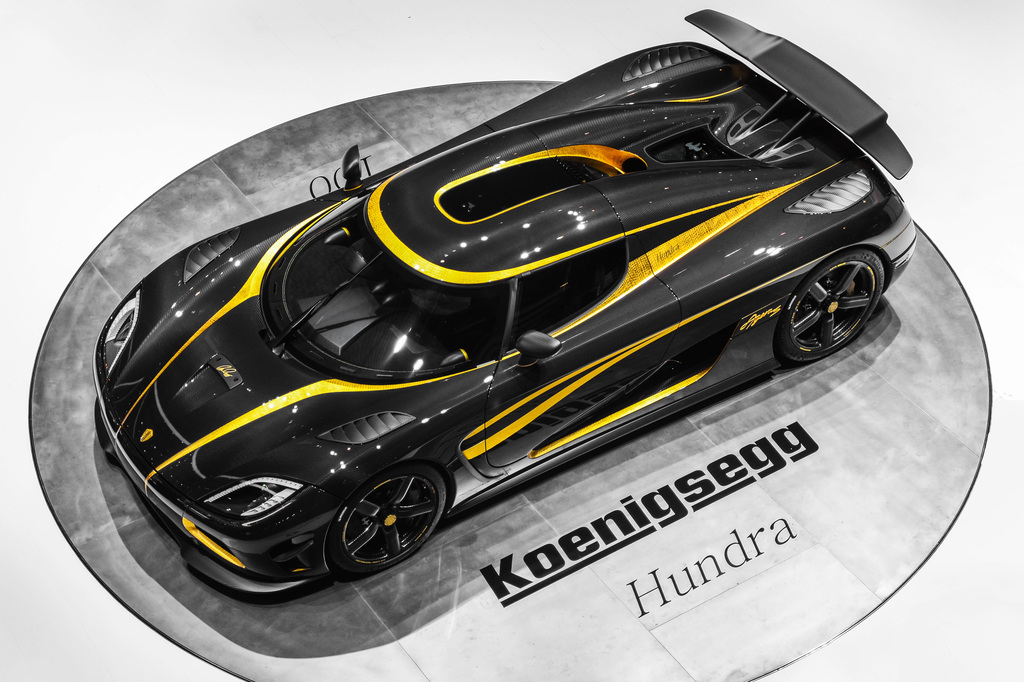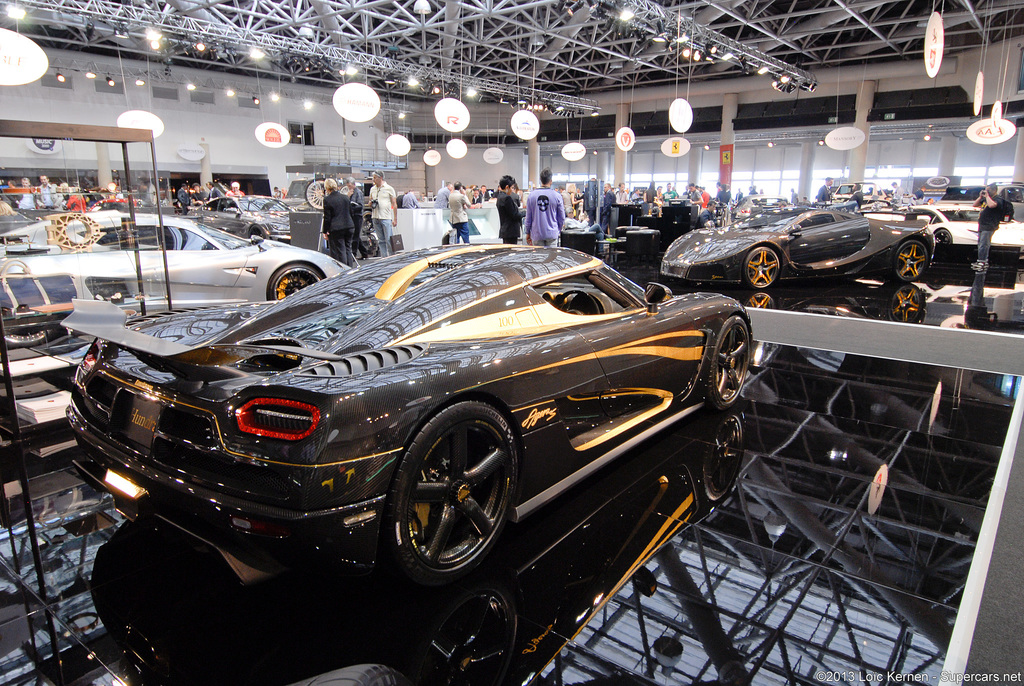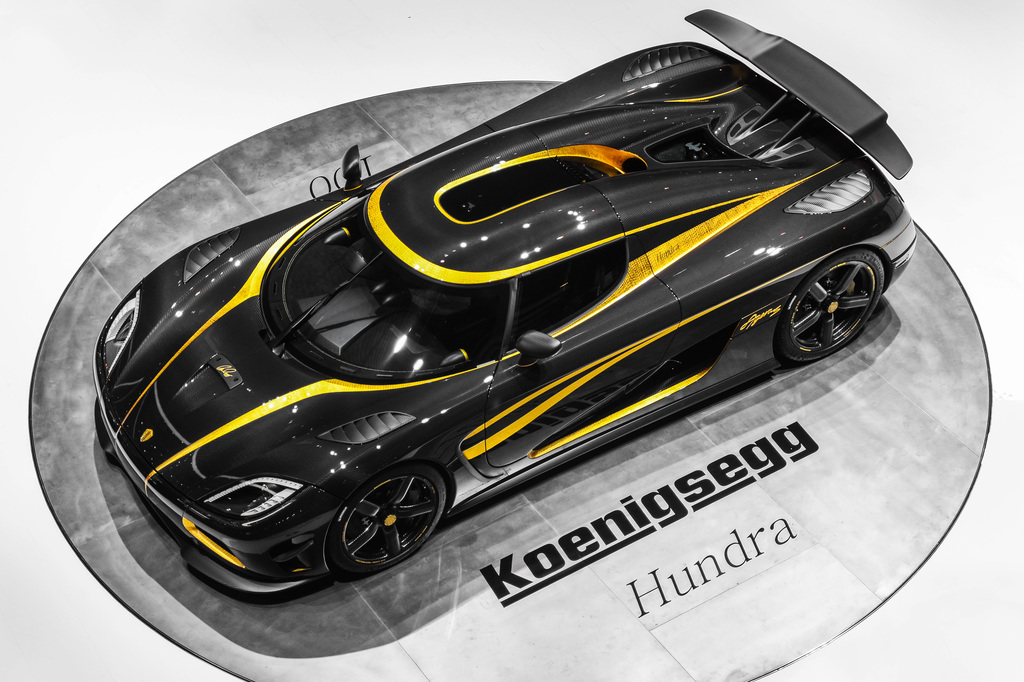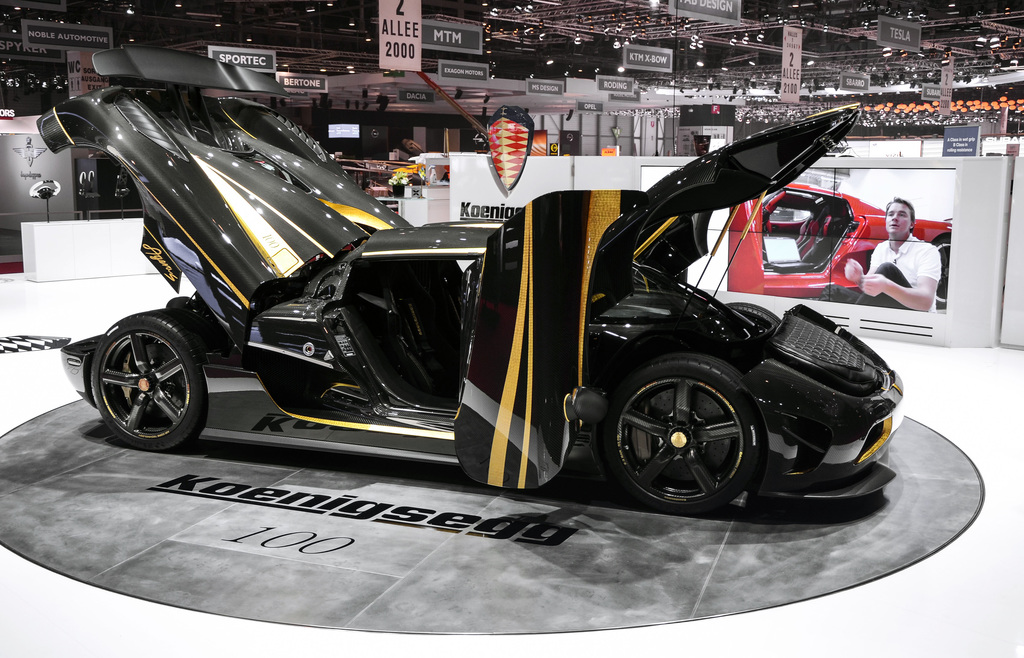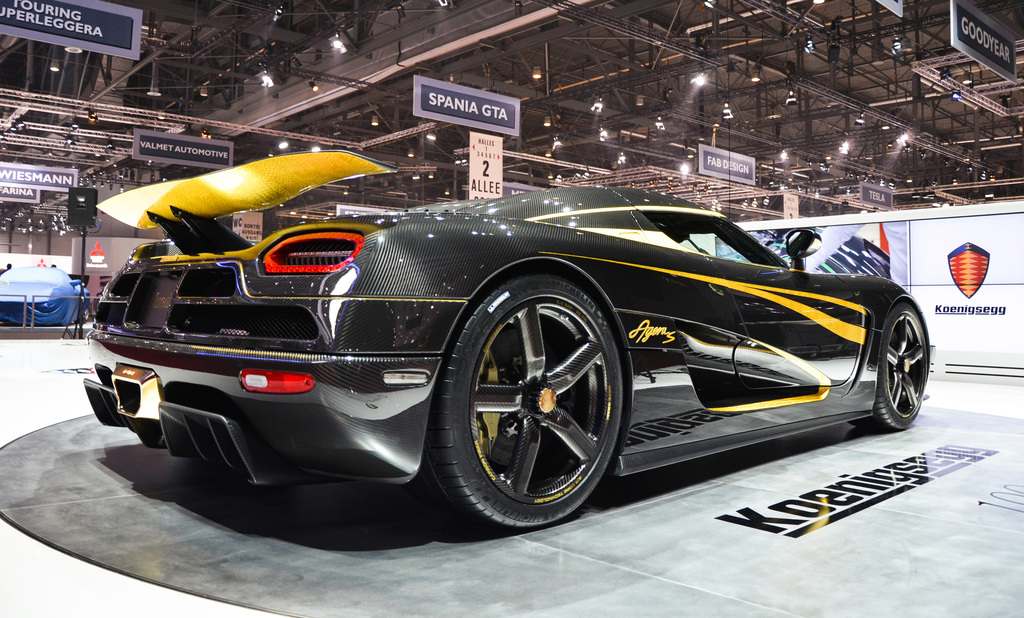2013 Koenigsegg Agera S
The Agera S was created for markets which do not have E85 fuel. The Agera S has all the features and functions of the Agera R apart from the flexfuel capability. Still amazingly Koenigsegg has managed get 1100 nm torque and a full 1030 hp when the car is run on 98 octane RON or 93 octane DIN.
In order to give the Agera S maximum flexibility when it comes to power delivery, Koenigsegg has implement the latest technology when it comes to turbo materials and design. The reduce inertia of the turbine wheel and axle gives improved response.
Triplex rear suspension
Christian von Koenigsegg has invented a new type of rear suspension system for a road car – Triplex rear suspension. The Agera S comes with the Triplex rear suspension system as standard and therefore has a shock absorber and spring connecting the right and left rear wheel. This system gives unique benefits as the two rear wheels can influence one another when desired.
There are multiple benefits of this system. For example, the Triplex system works in series with the normal springs and dampers, allowing their spring and damping rates to be lowered. This results in increased comfort and better handling on rough and wet surfaces without compromising dry track handling.
The Triplex system also has an anti-squat effect. Traditional anti-squat systems are designed into the geometry of the suspension. These systems do not add any components or weight. However they compromise the geometry of the suspension for other aspects of handling aside from anti-squat.
By adding the Triplex system, Koenigsegg can maintain true suspension geometries for handling, but still have the anti-squat feature and harvest other new found benefits. As the Triplex system compliments the normal dampers and springs, these can be made lighter. Hence, the added benefit does not significantly affect the overall weight of the car’s suspension.
Koenigsegg Agera S Images & Photos
See full Koenigsegg Agera S Gallery and watch Koenigsegg Agera S Videos
See full Koenigsegg Agera S Gallery and watch Koenigsegg Agera S Videos
Dynamic rear wing
Hypercars of today generate massive amounts of downforce at low to medium speed and less down force at very high speed. This is so as to avoid overloading the tires and creating too much drag. Most hypercars therefore have heavy, hydraulically operated wings and flaps to cater for this need.
Koenigsegg however, following the “less is more” philosophy, has designed a dynamic system to that take care of these needs.
The most visual and obvious part of this system is the new dynamic rear wing. The wing changes its angle of attack, not with the help of hydraulics, but with the pressure of the wind. It is therefore dynamically controlled by the vehicle speed, or wind resistance, at any given moment in time and thus actually compensates for headwind or tailwind at the same given road speed. This is an intelligent way of dealing with adaptive aerodynamics as the system becomes lighter, less complex and more intuitive compared to heavy and complex hydraulics systems. Koenigsegg had to work heavily with CFD in order to create the dynamically controlled adaptive aerodynamics of the Agera S.
An interesting additional feature of the adaptive wing is that the pylons for the wing also act as air extrusion channels. The air channels go from the engine bay to the back of the pylons, thereby creating an air passage. This causes a venturi effect from the air rushing past the pylon, evacuating hot engine bay gases, reducing pressure in the engine bay and increasing the flow of cooling air through the side radiators. This also means that the pressure under the car is reduced, giving more low drag down force.
Aircore Carbon fiber wheels
The 2014 Agera S features the world’s lighest and strongest Hypercar wheels, developed and produced by Koenigsegg. What makes this wheel truly unique is that the spokes and centre part of the wheel are completely hollow and made out of carbon, in one piece – together with the rest of the wheel.
This design demanded that Koenigsegg come up with a novel way of producing a one-piece hollow carbon construction, something much more complex than what has been allowed previously. The only metal part in the Koenigsegg Aircore carbon fiber wheel is the checkvalve for filling up the tire. Apart from this tiny part, the whole wheel is only made from carbon. Given its unique design, the wheel’s strength is much higher than any forged aluminium wheel, but at the same time it delivers a weight saving of 41%.
See full Koenigsegg Agera S Gallery and watch Koenigsegg Agera S Videos
This drastic reduction in weight brings massive benefits when it comes to performance. Everyone understands that unsprung weight should be keept at a minimum in order to have maximum performance. What is not so well understood is that the rotational mass should be kept to a minimum. Every time the car accelerates or brakes this rotational mass works against the objective of quick acceleration or short braking distance. In addition, the steering feel and keenness is affected by the rotational mass, as the rotational mass acts as a gyro, counteracting turning. Simply put, reducing the rotational mass not only gives less unsprung weight and a lighter car, but it also increases the dynamic power that goes into the ground while accelerating or braking. Reducing the rotational mass gives similar effect as equipping the car with larger brakes and more horsepower on top of saving weight and improving handling.
The Koenigsegg Aircore Carbon Wheel is a fantastic solution for overall performance improvement. Koenigsegg truly reinvented the wheel.
The design
The Agera S is designed with a minimalistic “less is more” philosophy in mind. This philosophy dictates that the shape of the car has to be purely functional, with no added features except those needed to meet regulations, or enhance safety, ergonomics, practicality or aerodynamics. We believe that if this philosophy is followed, the car will be as beautiful as it is purposeful. A good analogy is the evolution of the dolphin, a species that has had to meet similar criteria in order to reach its present configuration through the evolution of nature.
The Agera S has handsome proportions. It´s compact and muscular. Its timeless, efficient and distinctive shape is a true testament to good design. The original shape and concept of the Koenigsegg CC, created over 15 years ago, is still valid, fresh and highly competitive today. The Agera S manages to stay true to the philosophy, shape and size of the original CC. At the same time it looks, feels and performs like something belonging to the future.
The engine
Koenigsegg differs from other low volume hypercar manufacturers by the fact that we develop and produce our own engines in-house. Most observers and/or competitors consider this to be more or less impossible, or way too expensive to even consider. Koenigsegg has proved them wrong, year after year.
Not only are the engines developed in-house, they also have class-leading characteristics in many important areas. They are the lightest and most compact hypercar engines in the world, weighing only 197kg complete with flywheel, clutch, dry sump system, Inconel exhaust manifold and turbo. The low engine weight is quite astonishing as the Agera S engine also has class-leading power and torque characteristics. The Koenigsegg 5 litre V8 bi-turbo engine develops 1030 hp on 98 octane RON or 93 octane DIN. The Agera S has over 1000 Nm of torque from 2700 rpm and 1100 nm from 4100 rpm, showing great flexibility.
These are extraordinary numbers considering the size and reliability of the engine and they are obtained with no sacrifice of either drivability or flexibility. This is truly downsizing without compromise. These characteristics make it one of the most flexible and easy-to-use hypercar engines in the world.
To give a hint of how different the Agera S engine is compared to other production car engines, it is easy to look at the Brake Mean Effective Pressure value (BMEP) in the cylinders during maximum power output.
The transmission
The newly developed 7-speed gearbox for the Agera S features a world’s first dual clutch system for a single input shaft gearbox.
In order to keep the gearbox light, compact, strong and reliable, Koenigsegg chose to develop a new gearbox type in partnership with Cima, one that enables the use of a combination of both a dry and wet clutch systems in order to get class-leading shift times.
First, there is the normal twin-disc dry clutch that operates in a traditional fashion. Then there is a hydraulically operated wet clutch-brake inside the gearbox that is engaged during each upshift in order to slow down the input shaft as the gears are changed and prior to the normal synchronization. This cuts the synchronization time by two thirds as the gear is pre-synchronized. The result is a very sporty, smooth and extremely fast shift.
Compared to a traditional DCT system, this gearbox is lighter, smaller, has less moving parts and gives a more distinct shift feel with almost no interruption to acceleration. Furthermore, the electro-hydraulic shift mechanism actuates the shift forks directly with no intermediate mechanical parts. This brings down the inertia of the shift mechanism and any potential slack is minimized since the shortest possible path of engagement is achieved. The entire transmission weighs only 81kg, which is by far the lightest 7 speed hypercar transmission in the world. The transmission can also be set in full-auto mode.
The small size and very low weight, considering the longitudinal 7 speed layout, made it possible to maintain the shortest-in-class rear overhang, thereby giving an excellent central mass position and maintaining neutral behaviour in extreme conditions.
The chassis
The Agera S´s unique carbon fibre monocoque chassis is designed to achieve its maximum stiffness without a roof, as the roof is detachable and stow-able in the front of the car. This in itself is an unusual feature for such a compact hypercar.
The Koenigsegg carbon monocoque chassis has an astonishing level of stiffness, measures at 65.000 Nm/deg. It weighs just 70kg, including the integrated fuel tanks.
The result of constant weight saving exercises is a dry weight of only 1330kg, making the Agera S the lightest, fully homologated hypercar presently in production.
Suspension
The suspension geometry of the Agera S was designed to further enhance the award winning behaviour of the CCX. The Agera S’s track is wider at the front, compensating for the narrower front tires and giving the car a square stance of 2 meters in both the front and the rear.
In typical Koenigsegg tradition, the Agera S has the longest wishbones of all hypercars presently in production. Long wishbones have several advantages – for example: less track width deviation during wheel movement or cornering and improved geometry over a longer wheel stroke. This is one of the reasons why F1 cars have very long wishbones. The wishbones are produced from seamless aeronautical chrome-molybdenum tubing in order to minimise weight while offering maximum strength and stiffness.
The extremely strong and light uprights are machined from 7075-T6 aeronautical grade aluminium, and contain 240mm SKF dual angle contact bearings, normally only found on LeMans prototype cars. The very large bearings contribute to the overall stiffness of the wheel assembly and therefore give better control, handling and comfort. The uprights have large 4.5″ diameter carbon fibre cooling ducts for the brake discs in order to maximise brake cooling.
Brakes
The Agera S is equipped with the absolute latest ABS technology, which is based on a lightweight, performance-oriented racing system. The system makes it possible for the ABS function to react differently, depending on the performance mode. Furthermore, the ABS braking system operates on massive 392×40mm and 380×34mm ventilated and drilled ceramic discs, for unparalleled braking performance and zero fade, regardless of track or road condition.
The Brake caliper are designed in-house by Koenigsegg. Rhe front calipers has 6 ceramic piston and the rear caliper 4 piston. The calipers are truly state of the art as their stiffness to weight numbers are unparalelled.
Koenigsegg Agera S Pictures
See full Koenigsegg Agera S Gallery
Koenigsegg Agera S Videos
and watch Koenigsegg Agera S Videos
Specs & Performance
| type | Series Production Car |
| released at | 2013 Geneva Motor Show |
| built at | Ängelholm, Sweden |
| price $ | $ 1,400,000 |
| price €/td> | €990,000 |
| price £/td> | £845,000 |
| engine | Koenigsegg V8 w/Dry Sump Lubrication |
| position | Mid Longitudinal |
| aspiration | Twin Turbo Superchargers |
| block material | Aluminum |
| valvetrain | DOHC, 4 Valves per Cylinder |
| fuel feed | Multi-Point Fuel Injection |
| displacement | 5000 cc / 305.1 in³ |
| bore | 91.7 mm / 3.61 in |
| stroke | 95.25 mm / 3.75 in |
| compression | 9.0:1 |
| power | 768.1 kw / 1030 bhp @ 7100 rpm |
| specific output | 206.0 bhp per litre |
| bhp/weight | 727.92 bhp per tonne |
| torque | 1000 nm / 737.6 ft lbs @ 4100 rpm |
| redline | 8250 |
| body / frame | Carbon Fibre/Kevlar Body over Carbon Fiber & Aluminum Honeycomb Semi-Monocoque w/Steel Front Cro-Moly Steel Subframe |
| driven wheels | RWD w/E-Diff |
| wheel type | Koenigsegg AicoreTM |
| front tires | 265/35 – 19Y Michelin Supersport |
| rear tires | 345/30 – 20Y Michelin Supersport |
| front brakes | Carbon Ceramic Discs w/6-Piston Calipers |
| f brake size | 36 x 392 mm / 1.4 x 15.4 in |
| rear brakes | Carbon Ceramic Discs w/6-Piston Calipers |
| r brake size | 34 x 380 mm / 1.3 x 15.0 in |
| front wheels | F 48.3 x 24.1 cm / 19 x 9.5 in |
| rear wheels | R 50.8 x 31.8 cm / 20 x 12.5 in |
| steering | Rack & Pinion w/Power Assist |
| f suspension | Double Wishbones w/Inboard 2-Way Adjustable VPS Dampers, |
| r suspension | Double Wishbones w/Inboard 2-Way Adjustable VPS Dampers, |
| curb weight | 1415 kg / 3120 lbs |
| dry weight | 1330 kg / 2933 lbs |
| weight distro | 44 % / 56 % |
| wheelbase | 2662 mm / 104.8 in |
| front track | 1700 mm / 66.9 in |
| rear track | 1650 mm / 65.0 in |
| length | 4293 mm / 169.0 in |
| width | 1996 mm / 78.6 in |
| height | 1120 mm / 44.1 in |
| transmission | 7-Speed AMT |
| tran clutch | Dual-Clutch |
| gear ratios | 3.364:1, 2.875:1, 1.773:1, 1.267:1, 1.000:1, 0.833:1, 0.711:1 |
| 0 – 100 kph | ~2.8 seconds |
| 0 – 200 kph | ~7.8 seconds |
| drag | 0.30 Cd |
| emission | 310 g/km |
| fuel capacity | 120 litres or 31.68 gal. |







